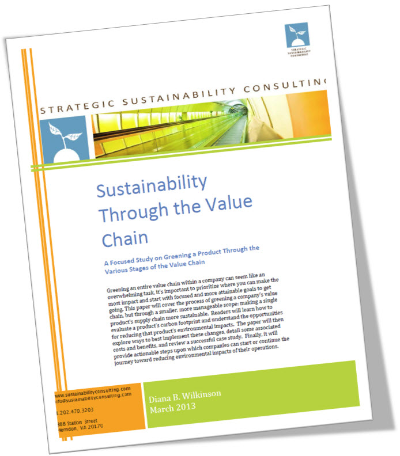Greening an entire value chain within a company can seem like an overwhelming task. Furthermore, not all companies have the resources to engage in a full-scale greening of their supply chain. For the small- and medium-sized companies, a targeted approach may be a more feasible option. By choosing one specific product, a company can more easily determine the environmental impacts of that one product and engage in actionable steps to reduce its footprint. It’s important to prioritize where you can make the most impact and start with focused and more attainable goals to get going.
The first step for companies looking to green the value chain of a specific product is to accurately measure the carbon footprint of that product. A Life Cycle Assessment (LCA) helps determine the product’s environmental impact by looking into the materials and energy used as well as how the product is manufactured, used, and disposed of post-use. Once a company has engaged in the LCA, it will need to identify the extent to which it wants to assess its value chain. Does it want to address issues at the very beginning of the chain, such as cultivating sustainable raw materials? Or does it make more sense to take a shorter view, such as the transportation of the product to the distribution center.
Now that the company has identified the appropriate portion of the supply chain on which to focus, it can now begin to make actual operational changes. These areas of improvement can include: changing a product’s raw materials, improving the product’s packaging contents and shape, addressing the logistics of the transport related to the product, and integrating end-of-life disposal into original product design. To properly integrate these changes into an operational model, management should clearly articulate their economic value and must bring the change in line with the larger business culture and objectives of the organization.
In order to justify what can often be a fairly substantial investment associated with greening a supply chain, management must clearly understand both the benefits and risks involved in the process. Benefits include cost reduction through increased efficiency, the company’s potential influence on external green policy initiatives, and the competitive advantage it gives a company. A risk that a company may experience could come in the form of supplier pushback, or even a decreased number of suppliers, if it employs stricter sustainability requirements. A loss in some product innovation can result, as companies may not be willing or able to use green supplies to create new products. Companies can also face internal, institutional resistance. However, by properly detailing and supporting the potential value creation of a greener product and implementing best-practice management, a company can mitigate many of these challenges.
Our latest white paper, “Sustainability Through the Value Chain,” covers the process of greening a company’s value chain, but through a smaller, more manageable scope: making a single product’s supply chain more sustainable. Readers learn how to evaluate a product’s carbon footprint and understand the opportunities for reducing that product’s environmental impacts. The paper then explores ways to best implement these changes, details some associated costs and benefits, and reviews a successful case study. Finally, it provides actionable steps upon which companies can start (or continue) the journey toward reducing environmental impacts of their operations.
To learn more, download this free white paper!

